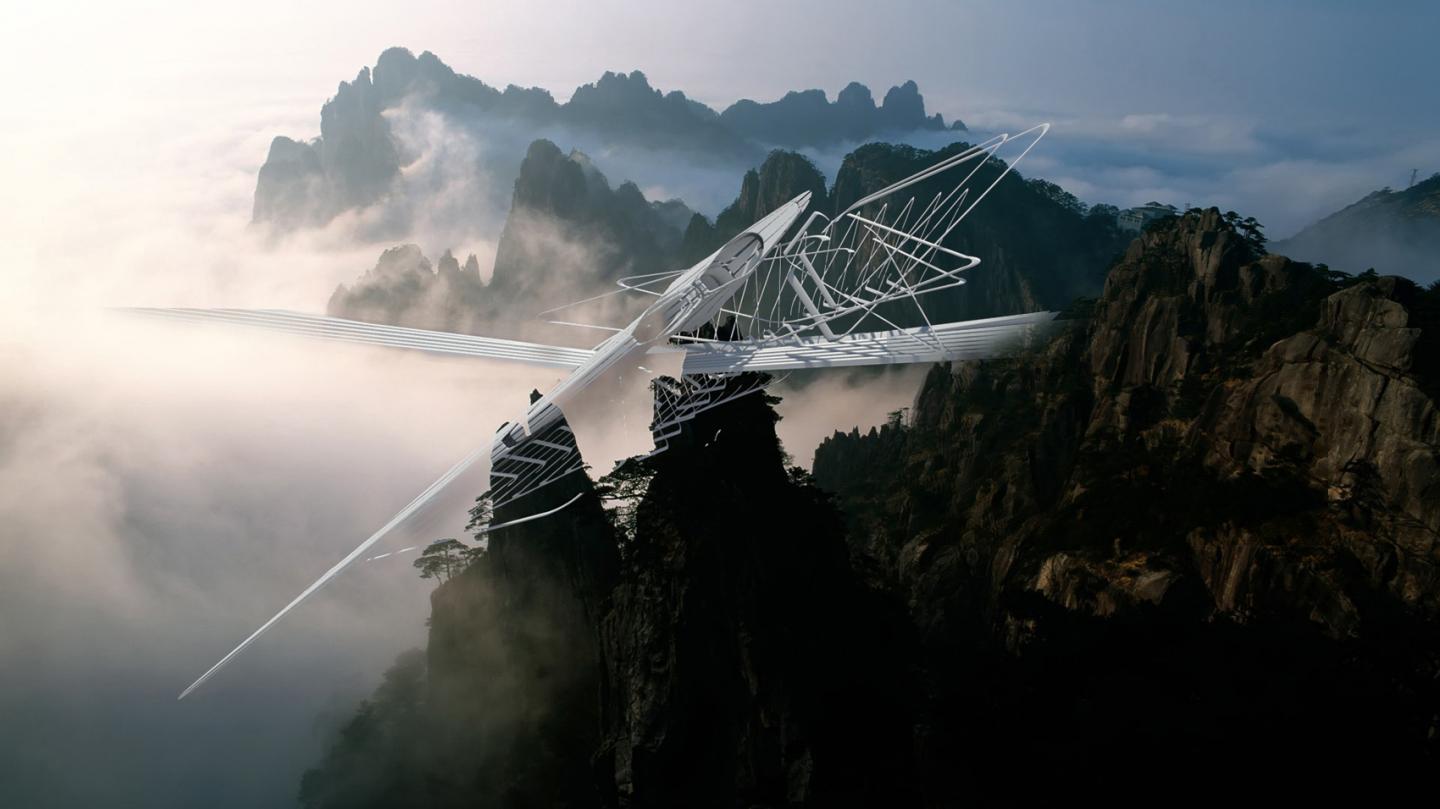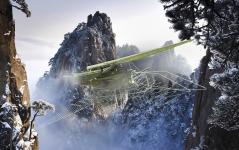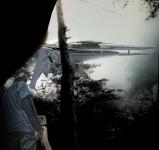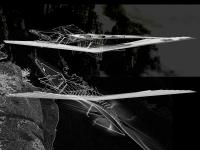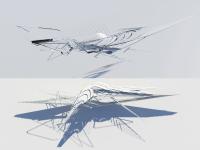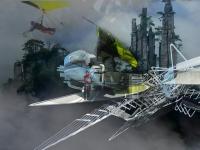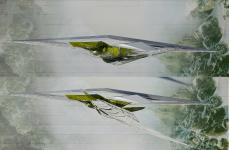The suspension footbridge in Tianmen, China, spans two mountains, and its design simulates that of the surrounding snow-capped mountain landscape. Further, it responds to the cloud-edge effect, capturing direct and reflected light to increase solar energy production. On cloudy days, its solar panels absorb diffused as well as reflective light, so that this bridge can achieve maximum exposure to solar energy. Moreover, its canopy is clad and fabricated with a highly reflective shifting carbon-fibre aluminium composite embedded with photovoltaic and piezoelectric cells.
Pedestrians have a birds-eye aerial view that changes with the weather, anticipating cloud-breaks and expanding horizon lines. The bridge stands at a height of 650 feet above the ground, wherein the design creates an illusion to camouflage it amidst the clouds and environment.
Maintaining static equilibrium balance and counterbalance is of structural importance, as the height, along with the exposure to elements, creates an unstable environment to design for. Additionally, rotational inertia is of primary concern, and integrating swinging cantilevered walkway lengths stabilises the structure as well as increases the moment of inertia without making it rigid, rather like the experience of a tightrope walker. The design moves and sways gently, which is a choreographed response to the upward air movement and cloud formation, offering pedestrians with not only spectacular views but also exposure to the very nature of the site, which can be intimidating at times.
Further, two interlaced footpaths are suspended from the structural axes of rotation, which dislocate and shift to rebalance the bridge, thus allowing for a safe crossing. Significantly, the canopy structure fragments in order to recalibrate the shifting weights, along the bridge’s cross-section, in a more efficient manner. This counterbalance is directed by the bridge’s pendulum weights suspended beneath the structure, which tighten and shift to restore equilibrium and maintain structural stability. Moreover, balance is retained and controlled by the cantilevered elements that swing slowly and methodically to reinstate the bridge to a stable horizontal position. Design inspirations in this regard include a collapsible push puppet similar to the suspended pendulums, which when in tension due to the bridge’s natural movements, tighten and restrain the structure, enough to prevent it from revolving around its main frame, by retaining the moment of inertia. Interestingly, the experience of the bridge was influenced by that of a rope bridge suspended over the river Mekong, which makes pedestrians crossing it more responsible for their own safety. However, this is an extreme experience, and I believe in one wherein the design does not intimidate or patronise the pedestrian.
The canopy’s dislocating fragments are clad with a carbon-fibre reinforced aluminium composite, which is lighter than aluminium for its weightlessness and is flexible enough for the cantilevered movements yet stronger than steel. This helps in limiting wear and tear, in addition to providing stability through 45-degree torsions and adapting to the external forces of the cantilever frames’ movements, whilst accommodating complex shifting shapes.
In addition, a motion capture system, sandwiched between the primary and tertiary structure, records the canopy movements, choreographing the synchronicity between the edge cloud cover, solar panels and footpath walkways made from steel-framed sections lined with rubber, to absorb unnecessary load-bearing changes arising due to the bridge retaining horizontal inertia. Self-healing polymers have been used to support internal mechanisms and slide surfaces seamlessly, to transfer loads between separating canopy elements and skeleton frames. Moreover, the canopy’s structural deformity under load has a series of polymer sheaths in between the separating elements that protect the design from wear and tear, similar to a plane’s wing.
The canopy also shifts with passing clouds, revealing glimpses of the horizon and views visible only for a minute and lost in the next. A patchwork of visual context is also present, similar to the patchwork canopy of elements not too dissimilar from clouds or kites that swivel and shift, attempting to capture as much cloud-edge solar energy as possible. Light levels are monitored using sensors across the cross-section of the bridge, which anticipate a break in cloud cover to expose the beautiful natural surrounding landscapes in the process – a choreography between nature and technology, a dance simulating the co-existence of natural and artificial phenomena.
This project was partly designed in 2015 and is currently in the process of being technologically revised, to be more dynamic and energy efficient. Like mountain climbers, the people crossing this bridge are exposed to the elements and to the true nature of its surroundings. A turbulent and dangerous beauty, the environment is threatening yet awe-inspiring in the same breath. Further, this bridge moves with air currents, similar to a kite or airplane wing, allowing us to relate with our environment more honestly and less submissively. It is noteworthy that using harnesses while crossing this bridge is optional.
The shifting canopy elements resemble solar kites embedded with photovoltaic cells; these are lightweight, durable, non-corrosive and highly reflective, thus creating a continuous surface cantilevered from the primary axial structure. Additionally, these solar kites are CNC fabricated and can be positioned in several configurations, depending on the structural frame. Lightweight yet durable, these canopy elements split apart and can be easily locked into position. For a static surface canopy, they are laser cut sections that can be repositioned as well as replicated for other sites and programmatic uses. The materials used and the building techniques employed in this pendulum bridge reflect progressive engineering applied in aviation, particularly when dealing with the context’s fluid environmental dynamics and maintaining the structure’s integrity.
Digital fabrication is an essential construction technique employed in this project; all elements can be replicated and replaced cost-effectively, and they can be adapted to different scales, ranging from workshop model to site. The bridge also generates electrical power, making it easier to structurally maintain it by keeping these fabrication tools on site. Moreover, the bridge is self-motorised with direct and cloud-edge solar power, which generates enough electricity to animate, float and mechanically move the structure in order to restore balance by shifting dynamic loads, rather like a hang glider only with an external power source.
Applying semi-conductor piezoelectric crystal cells as a gate voltage to the design, by embedding them within the canopy and walkway, generates electricity through resistance. When mechanical pressure is exerted on these elements (for example, as pedestrians walk across the bridge or environmental mechanical dynamics alter the direct pressure on the fragmented canopy), the piezoelectric cells change the resistance, thereby generating and releasing direct electrical current to the motor in order to move the structure. This type of electronics maximises the efficiency of generating power, as a direct response to instability in design and context. To summarise, the piezoelectric pendulum bridge uses a natural equilibrium to monitor and capture electrical energy from either solar or mechanical movement, whilst trying to stabilise the momentum of inertia, so that it can function safely as a footpath and observation deck. The dual nature of its design responds directly to its immediate context, which provokes the nature of its program, sustainability and appropriation.
2019
0000
Project Information:
Location: Zhangjiajie, in the northwestern part of Hunan Province, China.
Client: Yandang Mountain Park, National parks of China.
Span: 100m
1. COMPOSITE CARBON FIBRE REINFORCED POLYMER SHELL. Elite Carbon Fibre manufacturers, U.K
2. Vacuum bagged composite fibre shell elements
3. epoxy laminate moulds for fibre glass construction. pressure sensitive tapes- Matrix composites, U.K.
4. technical textiles cantilever cladding, lighter than aluminium for weightlessness. Textile fibre materials determine stability through 45 degree torsions. The material adapts to the external forces of the cantilever and it's movement. carbon fibre basic material. Carbon fibre reinforced plastics allow for complex shapes more than steel or aluminium. weight saving. resin saturated cured elements, achieving lower weight for the cantilever.
5. 3m optical mirror film, light transmission. polymer film exhibits 99% light reflectance for interior and exterior cladding canopy elements.
6. Interior materials. Polyester films transforming between transparent and translucent states dependant on viewing angles, anti-reflective privacy films.
7. Tritium bars, acrylic sheet cladding. Betalight, Tritium application manufacturers.
8. Self healing polymers used to support internal mechanisms, sliding seem-less surfaces and load transfer attachments between canopy skin and skeleton frame. This structural deformity under load catering the telescopic composite fibre sections has a series of polymer sheets which protect the design from wear and tear similar to a plane wing.
9. Motion capture system, sandwiched between the primary and tertiary structure record the canopy movements, choreographing the synchronicity between edge cloud cover, solar panels and architectural elements.
11. The most challenging material is the Piezoelectric cells, which will be working in parallel with electroluminescence and photovoltaic cells. Contained in light refractive polymer sandwich panel by SensiTile Systems. Light transmission is very important in the clad elements which is why highly reflective carbon fibre is beneficial to the design along with PLEDS, enabling thin lighting displays with superior effect and simplicity to LCD'S. These Polymer Light Emitting Diodes are also used inside the hotel to transform the interior environment as necessary.
1. The body is made from structural aluminium 7076T6 and 2024-T3 aluminium-copper alloy
2. Fragmenting canopy is constructed from composite carbon fibre impregnated with epoxy resin and aluminium.
3.Non corrosive highly polished ALCLAD hangar cladding. This aluminium alloy has been humidity tested for life span allowing for wear and tear at high altitudes.
Project designed by Margot Krasojević
Ms Krasojević won the 2018 LEAF Award for "Best Future Building – Under Construction and Drawing
Board" for her "Self-Excavation Hurricane House" in Louisiana, US.
Ms Krasojević's `Hydroelectric House' design is a permanent
exhibit at The Futurium, Berlin, opening 5th September 2019.
The Turbine hotel is part of a television documentary by RAUM Films, Austria.
Ms. Krasojevic was nominated for the Energy Globe awards 2020
